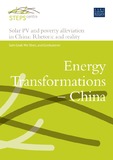Solar PV and poverty alleviation in China: Rhetoric and reality
| dc.contributor.author | Geall, Sam | |
| dc.contributor.author | Shen, Wei | |
| dc.contributor.author | Gongbuzeren | |
| dc.coverage.spatial | China | en |
| dc.date.accessioned | 2017-05-04T09:40:18Z | |
| dc.date.available | 2017-05-04T09:40:18Z | |
| dc.date.issued | 2017-05-02 | |
| dc.identifier.citation | Geall, S., Shen, W. and Gongbuzeren (2017) Solar PV and Poverty Alleviation in China: Rhetoric and Reality, STEPS Working Paper 93, Brighton: STEPS Centre | en |
| dc.identifier.isbn | 978-1-78118-366-3 | |
| dc.identifier.uri | https://opendocs.ids.ac.uk/opendocs/handle/20.500.12413/12969 | |
| dc.description.abstract | In 2014, China announced an ambitious plan to help alleviate rural poverty through deploying distributed solar photovoltaic (PV) systems in poor areas. The solar energy for poverty alleviation programme (SEPAP) initiative aims to add over 10 GW capacity and benefit more than 2 million households from around 35,000 villages across the country by 2020. This working paper traces the emergence and implementation of the initiative through discourse analysis of policy documents. Then, through a case study in the remote and largely pastoralist county of Guinan, in Qinghai province on the Tibetan plateau, we illustrate the constraints on implementing SEPAP and contested local perspectives on the buildout of ostensibly low carbon infrastructure for electricity generation. The working paper illustrates the limits of a top-down energy infrastructure push without incentive mechanisms for non-state actors or independent oversight of a “command and control” system. | en |
| dc.description.sponsorship | ESRC | en |
| dc.language.iso | en | en |
| dc.publisher | ESRC STEPS Centre | en |
| dc.relation.ispartofseries | STEPS Working Papers;93 | |
| dc.rights | Users are welcome to copy, distribute, display, translate or perform this work without written permission subject to the conditions set out in the Creative Commons licence. For any reuse or distribution, you must make clear to others the licence terms of this work. If you use the work, we ask that you reference the STEPS Centre website (www.steps-centre.org) and send a copy of the work or a link to its use online to the following address for our archive: STEPS Centre, University of Sussex, Library Road, Brighton BN1 9RE, UK (steps-centre@ids.ac.uk). | en |
| dc.rights.uri | http://creativecommons.org/licenses/by-nc-nd/3.0/ | en |
| dc.subject | Climate Change | en |
| dc.subject | Environment | en |
| dc.subject | Poverty | en |
| dc.subject | Technology | en |
| dc.title | Solar PV and poverty alleviation in China: Rhetoric and reality | en |
| dc.type | Series paper (non-IDS) | en |
| dc.rights.holder | ESRC STEPS Centre | en |
| rioxxterms.funder | Default funder | en |
| rioxxterms.identifier.project | STEPS Centre | en |
| rioxxterms.version | VoR | en |
| rioxxterms.funder.project | 7360ec74-14f4-4420-af2a-8ca314d07ffe | en |
Files in this item
This item appears in the following Collection(s)
-
ESRC STEPS Centre [225]
Except where otherwise noted, this item's license is described as Users are welcome to copy, distribute, display, translate or perform this work without written permission subject to the conditions set out in the Creative Commons licence. For any reuse or distribution, you must make clear to others the licence terms of this work. If you use the work, we ask that you reference the STEPS Centre website (www.steps-centre.org) and send a copy of the work or a link to its use online to the following address for our archive: STEPS Centre, University of Sussex, Library Road, Brighton BN1 9RE, UK (steps-centre@ids.ac.uk).


